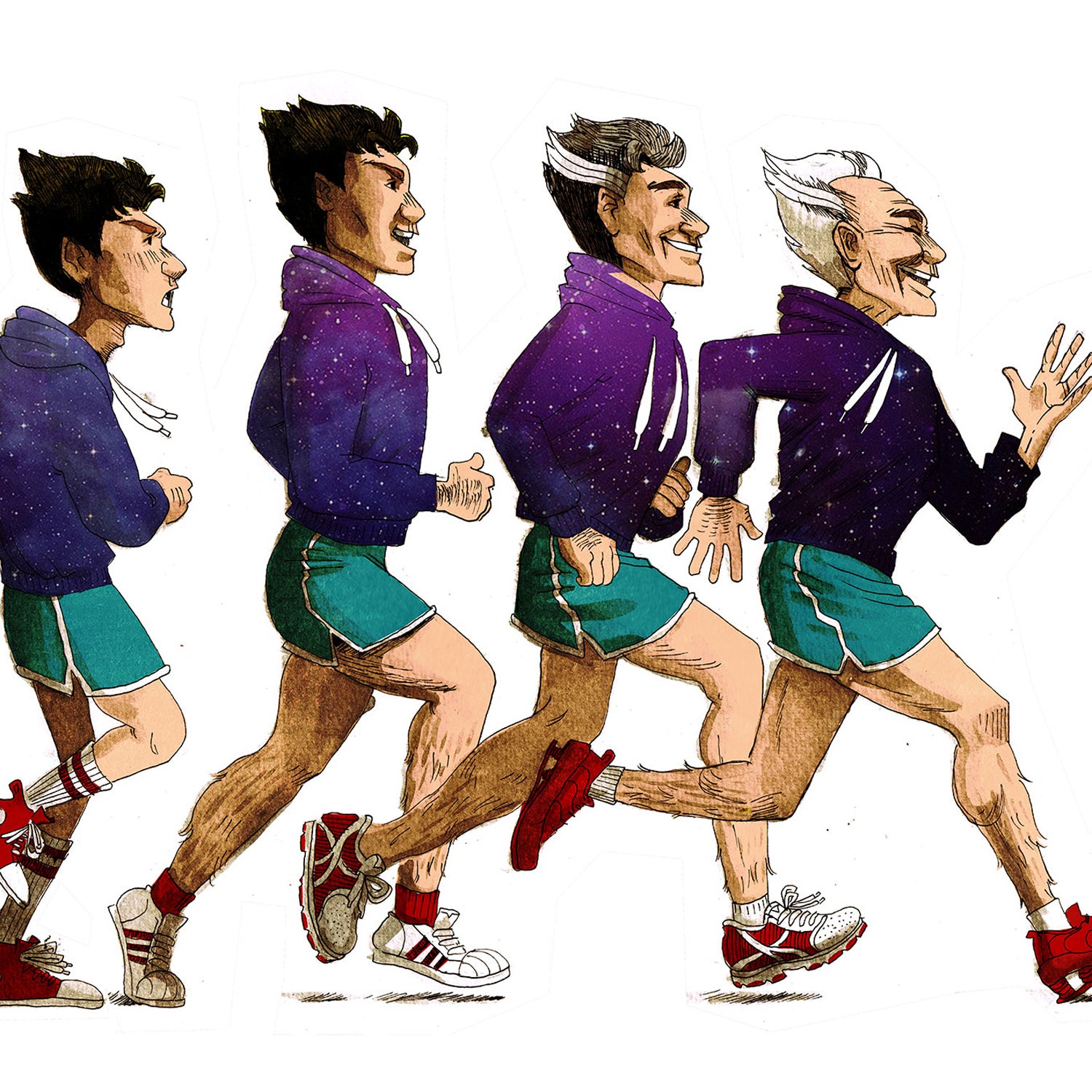Last February, 59-year-old Ned Overend, aka “The Lung,” aka “Deadly Nedly,” won the first , held in Ogden, Utah. Fat Bike Nats isn’t exactly the Tour de France, but it’s no charity ride, either. Overend had to compete against a field of much younger pros, including former national mountain bike champion Travis Brown, 46, on a tough 19-mile course.
It’s tempting to dismiss Overend as a genetic freak, an outlier who defies comparison with the rest of us. He has dominated nearly every sport he’s entered since the early ’90s, from cross-country mountain bike racing to off-road triathlon. But even among the genetically gifted—and many elite athletes are—Overend is unique in his competitive longevity. Which is the reason he’s also one of the dozen or so athletes spotlighted in Joe Friel’s latest book, (Velo Press), part of a growing library devoted to salt-and-pepper chargers past (and occasionally well past) the half-century mark.
I recently spent a few weeks immersed in Fast After 50, along with a few other books on the topic, including Margaret Webb’s , Lee Bergquist’s , and Bill Gifford’s excellent and entertaining . My interest was both professional and personal. I was staring down the gun barrel at 50, the ominous milestone, just a year and change away. Should I prepare to surrender to backgammon and bocce, or was there still hope for my lifelong addiction to biking, skiing, climbing, and other outdoor activities and races?
“As we age, exercise behavior (nurture) appears to play a significant role in how our given genetic biology (nature) plays out,” Joe Friel writes.
While all the books were informative, and even inspirational, chronicling many aging athletes who still excelled at their respective sports, Friel’s was the only one dedicated to mapping out a plan of action. A few years ago, Friel, 71, author of the classic Training Bible series and one of the most respected figures in endurance coaching, noticed that his own power on the bike was fading. His training group, which varied from young to old, routinely started dropping him on climbs, which had been rare in the past. Compelled to see if science offered any solutions, he dove into the research literature, which was limited but enlightening. Were there ways to beat time, the ultimate foe?
The news, it turns out, is good and bad. Good, because, yes, there are ways to fight the fade. Even if you can’t quite turn back the clock, you can actually slow it considerably and maintain a high level of performance deep into your sunset years. The bad news is that senescence—aging—remains, for now at least, inexorable, and effectively battling it requires diligence and work.
Friel lays out the science before launching into his trademark blueprint for sustaining, and even improving, high-end performance through your 50s, 60s, 70s, and beyond. The main factors that conspire against you are declining aerobic capacity, more body fat, shrinking muscles, and decreased mobility—the four horsemen of the fitness apocalypse, deterioration that accelerates as you get older.
But back to the good stuff. Friel argues that the most potent forces that affect aging have to do with behavior and lifestyle. “There is reason to believe that the major contributor to the performance decline in athletes as they get older is nurture, with nature playing a smaller role,” he writes. “[A]s we age, exercise behavior (nurture) appears to play a significant role in how our given genetic biology (nature) plays out.”
Friel ballparks nurture’s percentage at 60 to 70 percent. Let’s pause to consider this. If you buy Friel’s assessment, and you probably should because few people have been more involved in the study and application of exercise physiology than he has, he’s telling you that as much as 70 percent of your athletic power after turning 50 remains under your control. Have you heard better news today?
But how do you remain the same badass you’ve always been? How do you unleash your inner Ned?
Friel believes the key lies in intensity—that is, consistently jacking your heart rate into the upper echelons of its potential peak. Yet intensity is typically one of the first things to vanish from your workouts, maybe even your races, when you hit middle age. That’s because many athletes drift into long, slow distance (LSD), not because they are no longer capable of redlining, but because this type of training feels less taxing. But all those intervals you did in college? You never should have stopped. If anything, they become more vital as you get older.
“Training with an emphasis on high-intensity intervals has been my preferred method of preparing for races throughout my career,” Overend writes in Fast After 50. “I’ve learned that by reducing volume, I’m more rested for high-intensity sessions, and by being rested I can push myself harder during the intervals.”
Friel holds up a classic study from the 1970s led by Michael Pollock at the in Dallas, Texas, that looked at 24 competitive masters runners between the ages of 42 and 59. During the initial ten-year analysis, 13 of the runners ceased competing, though they continued to run long, slow distance as training. The other 11 continued to race at high intensity. While both groups put in about the same weekly mileage, the high-intensity runners saw their VO2 max drop a mere 1.6 percent, compared to the LSD group, whose VO2 max dropped a striking 12 percent. Recent longitudinal studies further support these findings.
All of the books in my survey echo a common refrain: “Use it or lose it,” with one twist. Don’t just use it—push it.
“Both training volume and intensity are important to the maintenance of fitness as we age,” writes Friel, “but intensity is more important.”
“Intensity” is another way to describe a kind of stress that prompts adaptive physiological changes. The idea of using exposure to stress as a way to improve athletic performance—or at least not lose it—also comes up in Gifford’s Spring Chicken when he introduces us to a chemical engineer from California named Todd Becker, aka the “world’s toughest nerd.”
Becker runs a health and fitness blog called and is an outspoken proponent of “hormesis”—a fancy term of Greek origin describing the stress-adaptation process. Becker is bullish on cold-water plunges, fasted workouts, weightlifting, sprinting, and other ways to nudge the body further to prompt positive adaptations. As Gifford points out, this is similar to the way vaccines work: Inject small doses of a virus into a host, which in turn generates the antibodies to protect you from the virus.
Delivering managed doses of stress followed by a well-managed recovery period, goes the theory, builds you back up stronger. Also known as periodization, this is the art and science behind almost all athletic training. It’s certainly a recurring theme in all of the books in my survey, which echo a common refrain: “Use it or lose it,” with one twist. Don’t just use it—push it.
If all this insistence on charging harder and exposing yourself to intense bouts of stress sounds scary, particularly in light of several recent stories about heart damage and even sudden death among endurance athletes, those fears are understandable but possibly irrational. Obviously, anyone (no matter their age) just starting on a training program should screen for preexisting conditions and clear things with their doctor. But the perception that high-intensity training is dangerous is overblown.
Friel spends the second half of Fast After 50 dishing the nuts and bolts to help you develop your own program. It’s worth noting here that he is writing primarily to experienced athletes chasing PRs into grandparenthood (or hoping the PRs won’t slip too far in the rearview mirror); this is not a fitness book for beginners, although committed newbies could certainly develop a training program based on the ideas here.
Fans of Friel’s Training Bible series will be familiar with the strategy: Set a goal such as a race or other objective where performance matters, and build a periodized training schedule to peak at the right time. This is the framework for staying fast, and Friel provides plenty of guidance for sorting out the specific training details that work for you. Finding the sweet spot between too little and too much is individualized but highly rewarding. Maintaining intensity is central, but it involves a lot more than hill repeats. You’ll also need to:
Lift Weights
“When you train with heavy loads for several weeks, you develop younger muscles,” Friel writes. “Lifting increases the body’s production of muscle building hormones such as growth hormone, testosterone, and insulin growth factor.”
Eat More Protein
“Recent research … strongly suggests that we need more [protein] as we age,” writes Friel. How much depends on myriad factors, which Friel gets into in his book. The general takeaway is to spread protein intake throughout the day, since the body is limited in how much protein it can process per meal.
Sleep Better, Longer
“Sleep is definitely the key to better performance with aging,” writes Friel. How much? “If you’re using an alarm clock to wake up, you’re not getting enough.”
Consider More Passive Recovery
If active recovery involves light activity—a short bike ride, an easy run—after a race or hard training session, passive recovery is doing basically nothing at all. Friel suggests weaving in more passive recovery as you age. Active recovery may still play a role, but you might find that taking a day (or two) completely off is even more beneficial. There may even be ways to enhance your passive recovery with things like compression tights, cold-water immersion, pneumatic sleeves, and massage.
Be Conservative
Training hard at middle age and beyond can be fraught with risk, as anyone who’s felt their back go sproing during a hard workout will tell you. Injuries heal more slowly as you get older, and that downtime can be tough. “Moderation and consistency” are the best way to ensure longevity and success, counsels Friel.
Watch: The 10 Commandments of Lifelong Fitness
Champion cyclist Ned Overend shares his secrets to crushing racers a third his age.


